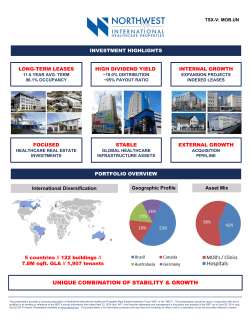
Weekly Market Commentary November 10, 2014 The Markets
Weekly Market Commentary November 10, 2014 The Markets Is it a melt-up? You’re familiar with the word melt. Ice cream melts. Snow melts. You may have seen someone melt down (or have done it yourself). Right now, markets may be experiencing a melt-up, according to Barron’s. Melt-up is a counterintuitive term which describes a sharp, emotion-driven improvement in market performance. Last June, The Wall Street Journal blog described the meltup phenomenon like this: “Money managers and analysts are beginning to talk about an idea that dates from the roaring ’90s: a rapid stock gain known as a melt-up. In the late ’90s, people thought a melt-up, or a sudden double-digit percentage rise, was a fine thing. Set off by some exciting event, melt-ups feed on their own gains as people rush to avoid missing out. In late 1999 and early 2000, the Nasdaq Composite Index surged to 5000 from 3000 amid the Internet frenzy. It then collapsed. Melt-ups, investors learned, can lead to meltdowns.” Markets did move higher last week. In fact, several major U.S. indices finished at record highs on the same day. That’s a rare occurrence and one that hasn’t happened since 1998. What was behind the move? Barron’s reported investors were encouraged by mid-term election results, strong thirdquarter earnings, and the European Central Bank’s promise to spend $1.25 trillion on quantitative easing. Investor optimism also gained ground. Last week’s American Association of Individual Investor’s (AAII’s) Sentiment Survey found a majority of investors were feeling bullish. Almost 53 percent believed stock prices would increase during the next six months. The bears were in retreat with pessimism about market performance falling to a nine-year low. “At current levels, optimism is unusually high and pessimism is unusually low. Historically, such occurrences have been followed by lower-than-average levels of market gains,” reported the AAII’s blog. So, is it a melt-up? It’s difficult to know. What’s really important is this: Melt-ups are buy first, think later situations which sometimes lead to melt downs, which are sell first, think later situations. Needless to say, it’s always better to think first. Data as of 11/7/14 Standard & Poor's 500 (Domestic Stocks) 10-year Treasury Note (Yield Only) Gold (per ounce) Bloomberg Commodity Index DJ Equity All REIT Total Return Index 1-Week 0.7% 2.3 -0.8 -0.1 0.1 Y-T-D 9.9% NA -3.9 -6.4 23.7 1-Year 16.3% 2.6 -11.7 -4.1 21.2 3-Year 17.2% 2.0 -13.5 -7.7 15.5 5-Year 13.2% 3.5 0.9 -2.5 17.9 10-Year 6.0% 4.2 10.3 -2.5 8.8 S&P 500, Gold, Bloomberg Commodity Index returns exclude reinvested dividends (gold does not pay a dividend) and the three-, five-, and 10-year returns are annualized; the DJ Equity All REIT Total Return Index does include reinvested dividends and the three-, five-, and 10year returns are annualized; and the 10-year Treasury Note is simply the yield at the close of the day on each of the historical time periods. Sources: Yahoo! Finance, Barron’s, djindexes.com, London Bullion Market Association. Past performance is no guarantee of future results. Indices are unmanaged and cannot be invested into directly. N/A means not applicable. LET’S HEAR IT FOR FAMILY BUSINESSES! Family-owned and family-controlled businesses are a pretty important part of the global economy. McKinsey & Company recently noted: “In many ways, family businesses are stronger, more vital, and more important than they have ever been. Various estimates peg their share of global GDP [gross domestic product] at between 70 and 90 percent. While many family businesses are private, about a third of the Fortune Global 500 companies are founder or family controlled, as are 40 percent of the major listed companies in Europe. Family businesses are especially important in emerging markets accounting for about 60 percent of private-sector companies with revenues of $1 billion or more.” According to The Economist, the largest family firms in the world span industries ranging from retail to automobiles to electronics to pharmaceuticals. The top 10 include four companies in the United States, along with firms based in Switzerland/United Kingdom, Germany, Italy, Russia, South Korea, and Taiwan. One of the most important challenges for family firms is succession. McKinsey & Company reported many businesses falter as they transition from the founder to the next generation, and most perish before the third generation can take the reins. Successful succession requires founders to look ahead, formulate a vision, and plan to that vision. In general, family-owned businesses have three basic options. The founder can: Give the business away and start a foundation. Sell the business and invest or divide the proceeds. Keep the business and pass it on to the next generation. McKinsey & Company predicts family companies are likely to become even more influential over time, especially in emerging markets. Weekly Focus – Think About It “Total spending by political parties in the British general election was £31.5m ($49.9m). Total spending by outside groups was £2.8m ($4.4m). So all in all: $54.3m. With 45.6m registered voters in Britain, that comes out at $1.19 per voter… That is less than the seventh most-costly Senate race (Arkansas), which cost $56.3m, or $26.47 per Arkansas voter. So the seventh costliest Senate race cost more than the entire 2010 general election in Britain.” --The Economist Securities offered through LPL Financial, Member FINRA/SIPC. * This newsletter was prepared by Peak Advisor Alliance. Peak Advisor Alliance is not affiliated with the named broker/dealer. * Government bonds and Treasury Bills are guaranteed by the U.S. government as to the timely payment of principal and interest and, if held to maturity, offer a fixed rate of return and fixed principal value. However, the value of fund shares is not guaranteed and will fluctuate. *Corporate bonds are considered higher risk than government bonds but normally offer a higher yield and are subject to market, interest rate and credit risk as well as additional risks based on the quality of issuer coupon rate, price, yield, maturity, and redemption features. * The Standard & Poor's 500 (S&P 500) is an unmanaged group of securities considered to be representative of the stock market in general. You cannot invest directly in this index. * The Standard & Poor’s 500 (S&P 500) is an unmanaged index. Unmanaged index returns do not reflect fees, expenses, or sales charges. Index performance is not indicative of the performance of any investment. * The 10-year Treasury Note represents debt owed by the United States Treasury to the public. Since the U.S. Government is seen as a risk-free borrower, investors use the 10-year Treasury Note as a benchmark for the long-term bond market. * Gold represents the afternoon gold price as reported by the London Bullion Market Association. The gold price is set twice daily by the London Gold Fixing Company at 10:30 and 15:00 and is expressed in U.S. dollars per fine troy ounce. * The Bloomberg Commodity Index is designed to be a highly liquid and diversified benchmark for the commodity futures market. The Index is composed of futures contracts on 19 physical commodities and was launched on July 14, 1998. * The DJ Equity All REIT Total Return Index measures the total return performance of the equity subcategory of the Real Estate Investment Trust (REIT) industry as calculated by Dow Jones. * Yahoo! Finance is the source for any reference to the performance of an index between two specific periods. * Opinions expressed are subject to change without notice and are not intended as investment advice or to predict future performance. * Economic forecasts set forth may not develop as predicted and there can be no guarantee that strategies promoted will be successful. * Past performance does not guarantee future results. Investing involves risk, including loss of principal. * You cannot invest directly in an index. * Consult your financial professional before making any investment decision. * Stock investing involves risk including loss of principal. Sources: http://online.barrons.com/articles/stock-indexes-at-new-highs-1415434384?mod=BOL_hp_we_columns (or go to http://peakclassic.peakadvisoralliance.com/app/webroot/custom/editor/11-10-14_BarronsStock_Indexes_at_New_Highs-Footnote_1.pdf) http://blogs.wsj.com/moneybeat/2014/06/15/blast-from-the-past-are-stocks-melting-up/ http://blog.aaii.com/category/aaii-survey/ http://www.mckinsey.com/search.aspx?q=family+companies (Scroll down and click on “Perspectives on Founder- and Family-Owned Businesses”, pages 4, 5, and 8) http://www.economist.com/blogs/graphicdetail/2014/11/daily-chart-0 (or go to http://peakclassic.peakadvisoralliance.com/app/webroot/custom/editor/11-10-14_The_EconomistRelatively_Successful-Footnote_5.pdf) http://www.economist.com/blogs/democracyinamerica/2014/11/big-money-politics (or go to http://peakclassic.peakadvisoralliance.com/app/webroot/custom/editor/11-10-14_The_EconomistTwo_Depressing_Thoughts-Footnote_6.pdf)
© Copyright 2025





















